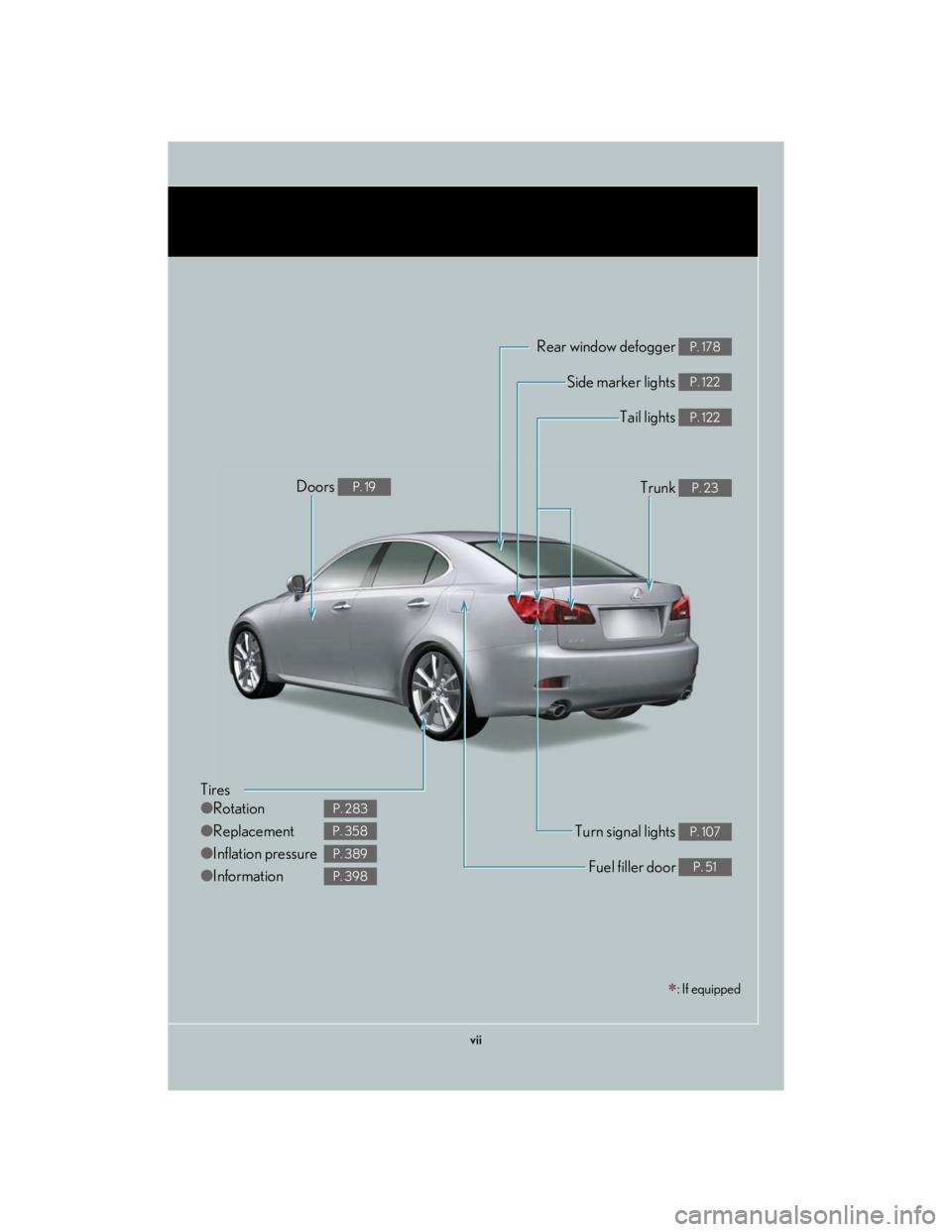fuel Lexus IS250 2007 Basic Functions / LEXUS 2007 IS350/250 OWNER'S MANUAL (OM53578U)
[x] Cancel search | Manufacturer: LEXUS, Model Year: 2007, Model line: IS250, Model: Lexus IS250 2007Pages: 445, PDF Size: 9.85 MB
Page 2 of 445

TABLE OF CONTENTSIndex
ii
1-1. Key information .............................. 2
Keys ......................................................... 2
1-2. Opening, closing and locking
the doors and trunk ..................... 4
Smart access system with
push-button start ............................. 4
Wireless remote control ............... 16
Doors..................................................... 19
Trunk..................................................... 23
1-3. Adjustable components ............ 26
Front seats .......................................... 26
Driving position memory ............. 28
Seat position memory .................... 31
Head restraints................................. 33
Seat belts ............................................ 34
Steering wheel
(manually adjustable type) ....... 40
Steering wheel
(power-adjustable type)............. 41
Anti-glare inside rear view
mirror ................................................ 42
Outside rear view mirrors ........... 43
1-4. Opening and closing the
windows and moon roof .......... 45
Power windows................................ 45
Moon roof ......................................... 481-5. Refueling ......................................... 51
Opening the fuel tank cap............ 51
1-6. Anti-theft system ......................... 54
Engine immobilizer system ......... 54
Alarm.................................................... 56
Theft prevention labels
(U.S.A.) ............................................ 58
1-7. Safety information ....................... 59
Correct driving posture ............... 59
SRS airbags ........................................ 61
Front passenger occupant
classification system .................... 72
Child restraint systems ................. 77
Installing child restraints .............. 80
2-1. Driving procedures..................... 90
Driving the vehicle .......................... 90
Starting the engine ......................... 98
Automatic Transmission ............. 101
Manual Transmission................... 105
Turn signal lever............................. 107
Parking brake ................................. 108
2-2. Instrument cluster ..................... 109
Gauges and meters ..................... 109
Indicators and warning
lights................................................... 115
1Before driving
2When driving
Page 5 of 445

1
2
3
4
5
6
7
v
Fuel pump shut off system ........ 336
Event data recorder .................... 337
5-2. Steps to take in an
emergency .............................. 339
If a warning light turns on or
a warning buzzer
sounds... ....................................... 339
If a warning message is
displayed....................................... 344
If you have a flat tire.................... 358
If the engine will not start .......... 366
If the shift lever cannot be
shifted from P .............................. 367
If you lose your keys ................... 368
When the electronic key
does not operate properly .... 369
If the vehicle battery is
discharged ................................... 372
If your vehicle overheats ........... 375
If the vehicle becomes
stuck................................................ 377
6-1. Specifications............................ 380
Maintenance data ....................... 380
Fuel information ............................ 395
Tire information............................ 398
6-2. Customization .......................... 406
Customizable features .............. 4066-3. Initialization .................................. 411
Items to initialize .............................. 411
Reporting safety defects
for U.S. owners............................ 414
Alphabetical index................................ 416
What to do if... ...................................... 425
6Vehicle specifications
7For US owners
Index
Page 7 of 445

vii
: If equipped
Tires
●Rotation
●Replacement
●Inflation pressure
●Information
P. 283
P. 358
P. 389
P. 398
Tail lights P. 122
Side marker lights P. 122
Trunk P. 23
Rear window defogger P. 178
Doors P. 19
Fuel filler door P. 51
Turn signal lights P. 107
Page 15 of 445

xv
D
Rear sunshade switch P. 233
Trunk opener P. 23
Fuel filler door opener P. 51
Headlight cleaner switch P. 129
Satellite switches P. 222
Instrument panel light
control dial
P. 110
: If equipped
*1: Refer to “Navigation System Owner's Manual”.
Page 16 of 445

xvi
For your information
Main Owners Manual
Please note that this manual applies to all models and explains all equipment, includ-
ing options. Therefore, you may find some explanations for equipment not installed
on your vehicle.
All specifications provided in this manual are current at the time of printing. How-
ever, because of the Lexus policy of continual product improvement, we reserve the
right to make changes at any time without notice.
Depending on specifications, the vehicle shown in the illustration may differ from
your vehicle in terms of color and equipment.
Accessories, spare parts and modification of your Lexus
A wide variety of non-genuine spare parts and accessories for Lexus vehicles are
currently available in the market. You should know that Toyota does not warrant
these products and is not responsible for their performance, repair, or replacement,
or for any damage they may cause to, or adverse effect they may have on, your
Lexus vehicle.
This vehicle should not be modified with non-genuine Lexus products. Modification
with non-genuine Lexus products could affect its performance, safety or durability,
and may even violate governmental regulations. In addition, damage or perfor-
mance problems resulting from the modification may not be covered under war-
ranty.
Installation of a mobile two-way radio system
As the installation of a mobile two-way radio system in your vehicle could affect
electronic systems such as the multiport fuel injection system/sequential multiport
fuel injection system, cruise control system, anti-lock brake system, SRS airbag sys-
tem and seat belt pretensioner system, be sure to check with your Lexus dealer for
precautionary measures or special instructions regarding installation.
Page 19 of 445

Before driving1
1
1-1. Key information ............................ 2
Keys....................................................... 2
1-2. Opening, closing and locking
the doors and trunk................... 4
Smart access system with
push-button start .......................... 4
Wireless remote control............. 16
Doors.................................................. 19
Trunk .................................................. 23
1-3. Adjustable components .......... 26
Front seats ....................................... 26
Driving position memory .......... 28
Seat position memory ................. 31
Head restraints.............................. 33
Seat belts ......................................... 34
Steering wheel
(manually adjustable type) .... 40
Steering wheel
(power-adjustable type) .......... 41
Anti-glare inside rear view
mirror ............................................. 42
Outside rear view mirrors ........ 431-4. Opening and closing the
windows and moon roof ....... 45
Power windows ............................. 45
Moon roof ....................................... 48
1-5. Refueling ...................................... 51
Opening the fuel tank cap ......... 51
1-6. Anti-theft system ...................... 54
Engine immobilizer system ...... 54
Alarm ................................................ 56
Theft prevention labels
(U.S.A.) .......................................... 58
1-7. Safety information .................... 59
Correct driving posture ............ 59
SRS airbags ...................................... 61
Front passenger occupant
classification system.................. 72
Child restraint systems ............... 77
Installing child restraints ............ 80
Page 69 of 445

51
1
Before driving
1-5. Refueling
Opening the fuel tank cap
Perform the following steps to open the fuel tank cap.
■Before refueling the vehicle
Turn the engine switch OFF and ensure that all the doors and win-
dows are closed.
■Opening the fuel tank cap
Open the fuel filler door.
Turn the fuel tank cap slowly to
open.
Hang the fuel tank cap on the
back of the fuel filler door.
STEP1
STEP2
STEP3
Page 70 of 445

52
1-5. Refueling
Closing the fuel tank cap
When replacing the fuel tank cap,
turn it until a clicking sound is
heard.
After releasing your hand, the cap will
turn slightly to the opposite direction.
■Fuel types
Use unleaded gasoline. (91 Octane rating [Research Octane Number 96] or
higher)
■Fuel tank capacity
Approximately 17.2 gal. (65 L, 14.3 Imp. gal.)
■When the fuel filler door opener is inoperable
The lever can be used to open the fuel filler
door if the fuel filler door cannot be opened
using the inside switch because the battery is
discharged or for any other reason.
Page 71 of 445

53
1-5. Refueling
1
Before driving
CAUTION
■Refueling the vehicle
Observe the following precautions while refueling the vehicle. Failure to do so, may
result in death or serious injury.
●Touch the vehicle or some other metal surface to discharge any static electricity.
Sparks resulting from discharging static electricity may cause the fuel vapors to
ignite.
●Always hold the grips on the fuel tank cap and turn it slowly to remove it.
A whooshing sound may be heard when the fuel tank cap is loosened. Wait until
the sound cannot be heard before fully removing the cap. In hot weather, pressur-
ized fuel may spray out the filler neck and cause injury.
●Do not allow anyone that has not discharged static electricity from their bodies to
come close to an open fuel tank.
●Do not inhale vaporized fuel.
Fuel contains substances that are harmful if inhaled.
●Do not smoke while refueling the vehicle.
Doing so may cause the fuel to ignite and cause a fire.
●Do not return to the vehicle or touch any person or object that is statically
charged.
This may cause static electricity to build up, resulting in a possible ignition hazard.
■When replacing the fuel cap
Do not use anything but a genuine Lexus fuel tank cap designed for your vehicle.
Failure to do so may cause a fire or other incident which may result in death or seri-
ous injury.
NOTICE
■Refueling
Do not spill fuel during refueling.
Failing to do so may damage the vehicle, such as causing the exhaust systems to
operate abnormally or damaging fuel system components or the vehicle's painted
surface.
Page 110 of 445

92
2-1. Driving procedures
■Breaking in your new Lexus
To extend the life of the vehicle, the following precautions are recommended to
observe:
●For the first 186 miles (300 km):
Avoid sudden stops.
●For the first 621 miles (1000 km):
• Do not drive at extremely high speeds.
• Avoid sudden acceleration.
• Do not drive continuously in the low gears.
• Do not drive at a constant speed for extended periods.
■Operating your vehicle in a foreign country
Comply with the relevant vehicle registration laws and confirm the availability of the
correct fuel. (P. 383)
■Normal characteristics after turning off the engine
Approximately five hours after the engine is turned off, you may hear sound coming
from under the vehicle for several minutes. This is because fuel evaporation leakage
check is performed. It does not indicate a malfunction.
CAUTION
■When starting the vehicle
With automatic transmission vehicles, always keep your foot on the brake pedal
while stopped with the engine running. This prevents the vehicle from creeping.
■When driving the vehicle
●Do not drive if you are unfamiliar with the location of the brake and accelerator
pedals to avoid depressing the wrong pedal.
Accidentally depressing the accelerator pedal instead of the brake pedal will
result in sudden acceleration that may lead to an accident that could result in
death or serious injury.
●Do not drive the vehicle over or stop the vehicle near flammable materials.
●With automatic transmission vehicles, do not let the vehicle roll backwards while
the shift lever is in a driving position, or roll forward while the shift lever is in R.
Doing so may cause the engine to stall or lead to poor brake and steering perfor-
mance, resulting in an accident or damage to the vehicle.